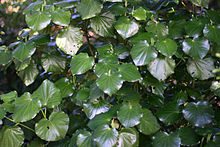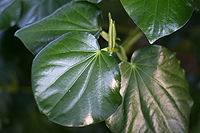- Macropiper excelsum
-
Kawakawa 
Scientific classification Kingdom: Plantae (unranked): Angiosperms (unranked): Magnoliids Order: Piperales Family: Piperaceae Genus: Macropiper Species: M. excelsum Binomial name Macropiper excelsum
(G.Forst.) Miq.Kawakawa, Macropiper excelsum, is a small tree of which the subspecies M. excelsum subsp. excelsum is endemic to New Zealand; the subspecies M. excelsum subsp. psittacorum is found on Lord Howe Island, Norfolk Island and the Kermadec Islands.
Contents
Description
It is found throughout the North Island, and as far south as Okarito (43.20 °S) on the West Coast and Banks Peninsula (43.5 °S) on the east coast of the South Island. The leaves are often covered with insect holes. The images depict the variety majus which has larger and more glossy leaves than M. excelsum. The name Kawakawa in Māori refers to the bitter taste of the leaves, from kawa bitter.[1]
Uses
Kawakawa is a traditional medicinal plant of the Māori. An infusion is made from the leaves or roots, and used for bladder problems, boils, bruises, to relieve pain or toothache, or as a general tonic. The sweet edible yellow berries (most often found in summer on female trees) of the plant were eaten as a diuretic.
The leaves of this plant are used to make Titoki Liqueur which is exported to Japan, Australia, Fiji and the United Kingdom. The seeds of this plant are employed as a culinary spice and they could be commercially used for that purpose, as this tree is related to Piper nigrum (Black pepper) and it is grown as an ornamental plant.
Host people of a marae wave leaves of kawakawa to welcome guests, especially at tangi. Both they and the guests may wear wreaths of kawakawa on the head as a sign of mourning.
See also
- New Zealand plants
External links
- Cook Islands Biodiversity Database
- Landcare Research plant database
- M. excelsum evaluation report
- Gardens and plants: Macropiper excelsum
Notes
- ^ It has also been surmised that when Māori first came to New Zealand, they named the plant 'Kawakawa' because they recognised that the plant was a close relative of Piper methysticum, the plant from which kava is made in the tropical Pacific. However, given that Macropiper species also occur in tropical Polynesia, it is more likely they simply applied the name of those plants to the New Zealand variety. In the Cook Islands and the Marquesas for instance, M.latifolium is known as 'Kavakava-atua'; in Samoa it is called 'Ava'ava-aitu'. M. latifolium is very similar in appearance to the New Zealand species, and is also used in traditional medicine in the Cook Islands.
References
- Brooker S.G., R.C. Cambie & R.C. Cooper, New Zealand Medicinal Plants. Heinemann, Auckland, 1981.
Categories:- Flora of Norfolk Island
- Magnoliids of Australia
- Piperaceae
- Trees of New Zealand
- Trees of Australia
- Fruit
- New Zealand cuisine
- Spices
- Ornamental trees
Wikimedia Foundation. 2010.

